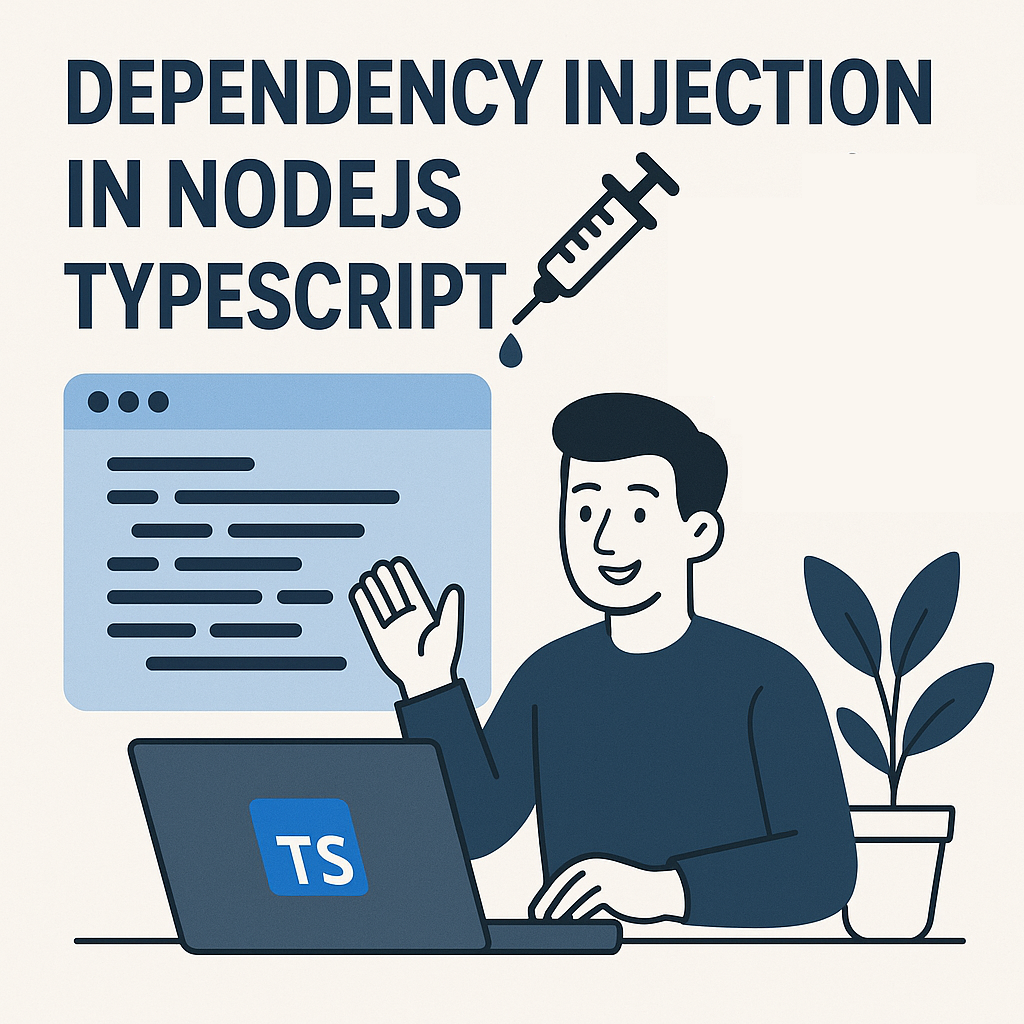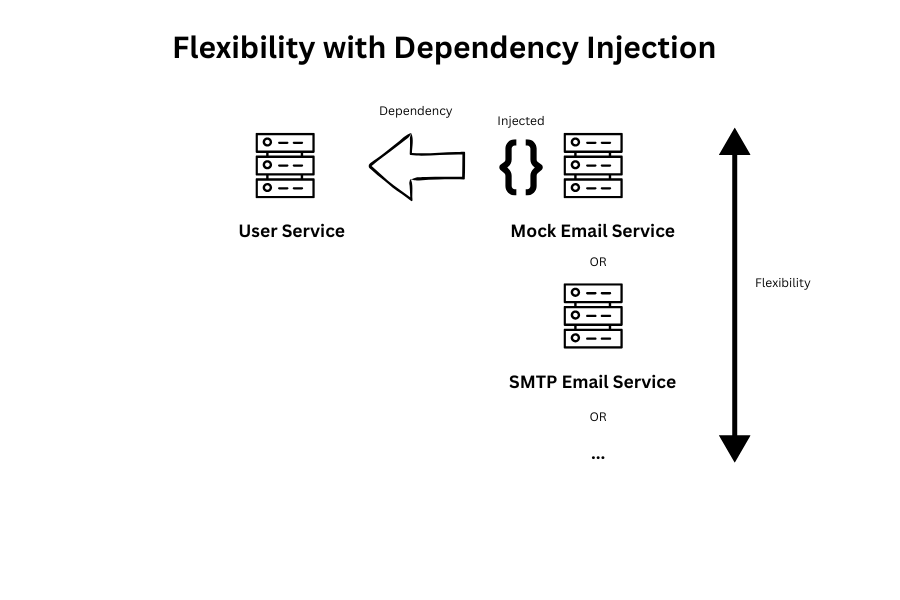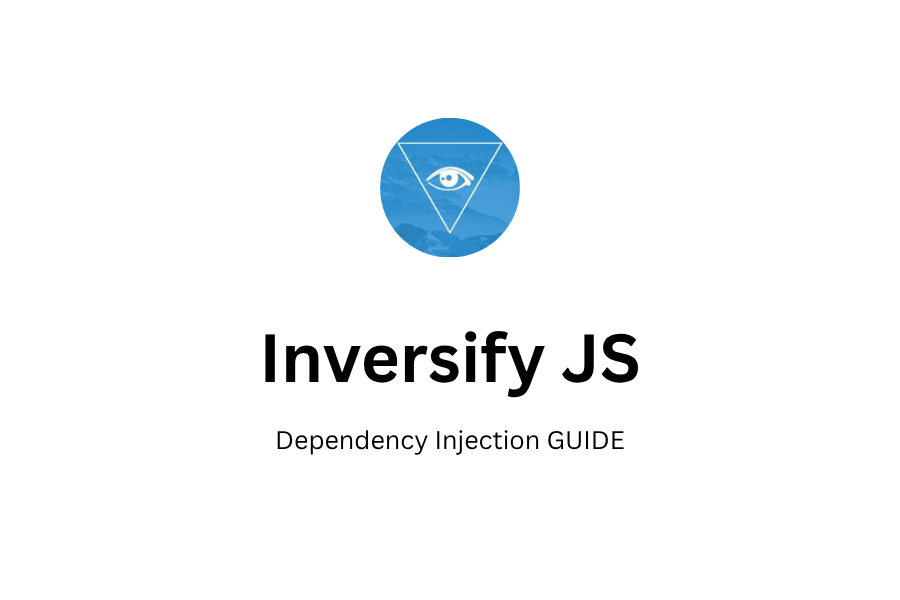Dependency Injection in NodeJS Typescript

Dependency Injection (DI) is a foundational design pattern in modern application architecture. It helps developers write modular, testable, and maintainable code — all by managing how components obtain their dependencies.
In this expanded guide, you’ll learn:
- What dependency injection is and why it matters
- How it improves flexibility and testing in Node.js
- What Inversion of Control (IoC) means
- How to implement DI using InversifyJS
- Common pitfalls, patterns, and real-world examples
What Is a Dependency?
A dependency is any external piece of code or resource that your component or class needs to perform its job. Dependencies can be:
- Another class or service (e.g.,
EmailService,Logger) - A database connection
- A configuration file or environment variable
- An external API wrapper or SDK
Example: Hard-coded dependency
class EmailService {
send(to: string, message: string) {
console.log(`Sending email to ${to}: ${message}`);
}
}
class UserRegistration {
private emailService = new EmailService();
register(email: string) {
// business logic
this.emailService.send(email, "Welcome!");
}
}
Here, UserRegistration depends directly on EmailService. This means:
- You cannot replace
EmailServicewithout editing the class. - It’s hard to test
UserRegistrationwithout sending real emails.
This tight coupling makes your code rigid and difficult to evolve.

Why Dependency Injection
The Problem: Tight Coupling
In many Node.js applications, it’s common to see classes that create their own dependencies directly inside their constructors or methods.
This works fine in small projects, but as soon as your codebase grows, it becomes a bottleneck for testing, flexibility, and maintenance.
class EmailService {
send(to: string, message: string) {
console.log(`Email sent to ${to}: ${message}`);
}
}
class UserRegistration {
private emailService = new EmailService(); // tightly coupled
register(email: string) {
// Business logic
this.emailService.send(email, "Welcome to our platform!");
}
}
This design couples UserRegistration to a specific implementation of EmailService.
If you later decide to replace EmailService with a third-party SDK, or mock it in tests, you’ll have to edit every class that depends on it.
That coupling cascades through the codebase. The more dependencies you hardcode, the harder it becomes to isolate logic, run tests independently, or make changes safely.
In short: hard-coded dependencies make codebases brittle.
The Solution: Loose Coupling Through Injection
Dependency Injection changes who is responsible for creating dependencies. Instead of letting a class instantiate what it needs, it receives those dependencies from the outside—typically via a constructor.
class UserRegistration {
constructor(private emailService: EmailService) {}
register(email: string) {
this.emailService.send(email, "Welcome!");
}
}
The difference is small in code, but massive in architecture.
The UserRegistration class no longer cares how the email service is built or configured—it only needs to know it can call send() on it.
This “inversion” gives external code the power to decide what version or type of dependency to provide.
Flexibility and Extensibility

With injection, you can easily replace or extend behavior without rewriting business logic. For example, you could switch between a development stub and a production email provider.
class MockEmailService extends EmailService {
send(to: string, message: string) {
console.log(`[MOCK] Pretending to send email to ${to}`);
}
}
class SmtpEmailService extends EmailService {
send(to: string, message: string) {
smtpClient.send({ to, message });
}
}
// Development
const userServiceDev = new UserRegistration(new MockEmailService());
// Production
const userServiceProd = new UserRegistration(new SmtpEmailService());
Because both implementations share the same interface, UserRegistration stays untouched.
This pattern lets you introduce new providers, features, or integrations simply by creating new implementations.
Easier Testing
Testing is one of the biggest reasons developers adopt dependency injection.
When your dependencies are injected, you can isolate the class under test and replace real services with simple mocks or fakes.
Without DI, you might have to initialize entire service graphs, real databases, or network clients just to test a single function.
With DI, you replace them with lightweight stand-ins:
const mockEmailService = {
send: jest.fn(),
};
const userService = new UserRegistration(mockEmailService as any);
userService.register("[email protected]");
expect(mockEmailService.send).toHaveBeenCalled();
This test runs instantly and doesn’t depend on any external systems.
You’re verifying logic, not infrastructure. That’s the essence of clean testing.
Supporting SOLID Principles
Dependency Injection directly supports two key principles of object-oriented design:
1. Dependency Inversion Principle (DIP)
High-level modules should not depend on low-level modules. Both should depend on abstractions.
Your service depends on the contract (EmailService interface), not on any specific implementation.
2. Open/Closed Principle (OCP)
Software entities should be open for extension but closed for modification.
When you inject dependencies, you can extend functionality by providing new implementations—without modifying existing classes.
These principles aren’t abstract theory; they lead to real-world benefits like fewer regressions, faster refactors, and safer feature rollout.
Centralized Configuration
In projects with many components, DI enables a single, centralized place to manage dependency wiring.
Instead of spreading “new” statements across files, you declare bindings in one configuration module or container.
container.bind(UserRegistration).toSelf();
container.bind(EmailService).to(SmtpEmailService);
This centralization helps when switching environments or adding new integrations.
You can replace dependencies in one location without changing any business logic or controller code.
Cleaner, More Readable Architecture
When dependencies are injected, they become explicit.
Each class’s constructor clearly declares what it needs to function.
Without DI:
class PaymentService {
constructor() {
this.logger = new Logger();
this.gateway = new StripeGateway();
}
}
With DI:
class PaymentService {
constructor(private logger: Logger, private gateway: PaymentGateway) {}
}
This transparency improves readability. Developers can glance at the constructor and immediately see all external requirements—no hidden logic or implicit creation.
Collaboration and Modularity
Dependency injection enables modular development.
When teams work on large systems, different engineers can build independent components that conform to shared interfaces.
For example, one developer might implement a PaymentGateway for Stripe while another builds one for PayPal. Both adhere to the same contract and can be injected interchangeably.
That kind of modularity is essential in scalable systems, plugin architectures, and multi-tenant SaaS platforms.
Maintenance and Scalability
As applications grow, dependencies evolve. You might introduce caching layers, feature flags, analytics hooks, or retry policies.
With DI, those enhancements can be added or swapped out without rewriting core logic.
A system designed around dependency injection can grow naturally—its components stay independent, and its wiring evolves externally through configuration rather than invasive code edits.
When teams talk about “architecture that scales,” this is what they mean: systems that adapt to change through structure, not rewrites.
Understanding the Problem DI Solves
Let’s look at a common three-layer architecture in Node.js:
Controller → Service → Repository → Database
Each layer depends on the one below it:
- The Controller handles routes and requests.
- The Service implements business logic.
- The Repository abstracts database access.
If dependencies are hard-coded, your test suite needs a real database. That slows down development, adds fragility, and violates isolation principles.
class UserService {
private repo = new UserRepository(); // tightly coupled
}
Now imagine you need to:
- Switch from MongoDB to PostgreSQL
- Cache repository results
- Log queries for debugging
You would have to edit the service directly, which ripples changes throughout the codebase.
With Dependency Injection
With DI, you can pass an abstracted dependency to the service constructor:
interface IUserRepository {
findByEmail(email: string): Promise<User | null>;
}
class UserService {
constructor(private repo: IUserRepository) {}
}
This allows:
- Injecting different repository implementations (real, mock, cached)
- Replacing layers independently
- Simplifying unit tests with mocks
This approach dramatically improves modularity and adaptability.
Inversion of Control (IoC)
Dependency Injection is part of a broader concept called Inversion of Control (IoC).
Traditionally, the application controls when and how objects are created.
With IoC, the control is inverted — the framework or container takes charge of object creation and dependency management.
In simple terms:
“Instead of your code calling the framework, the framework calls your code.”
Analogy
Imagine a movie director (IoC container) controlling when actors (objects) appear and what props (dependencies) they use.
The actors don’t bring their own props — the director provides them at runtime.
IoC vs DI
- IoC is the principle (handing over control)
- DI is one implementation of that principle (through constructor injection, setters, etc.)
This separation is key — DI is the practical mechanism that realizes IoC.
Implementing Dependency Injection with InversifyJS

Why InversifyJS?
InversifyJS is a TypeScript-friendly IoC container that makes dependency management seamless. It supports:
- Type-safe decorators (
@injectable,@inject) - Auto-resolution of dependencies
- Scoped and singleton bindings
- Integration with Express, Koa, and other frameworks
Step 1: Install Dependencies
npm install inversify reflect-metadata
In your tsconfig.json, enable TypeScript decorators and metadata:
{
"compilerOptions": {
"target": "ES6",
"lib": ["ES6"],
"module": "commonjs",
"experimentalDecorators": true,
"emitDecoratorMetadata": true}
}
And ensure to import this once (usually in your main entry file):
import "reflect-metadata";
Step 2: Define Identifiers (Symbols)
We’ll use symbols to uniquely identify injectable dependencies.
// types.ts
export const TYPES = {
Rider: Symbol.for("Rider"),
Bike: Symbol.for("Bike")
};
These symbols are how Inversify identifies your bindings at runtime.
Step 3: Create Injectable Classes
Use @injectable() to mark classes as available for injection.
Use @inject() to specify dependencies for constructor parameters.
// entities.ts
import { injectable, inject } from "inversify";
import { TYPES } from "./types";
export interface Bike {
throttle(): string;
}
@injectable()
export class SportsBike implements Bike {
throttle() {
return "Sports Bike — full speed ahead!";
}
}
@injectable()
export class Rider {
constructor(@inject(TYPES.Bike) private bike: Bike) {}
ride() {
return `Rider says: ${this.bike.throttle()}`;
}
}
This approach defines clear boundaries between abstractions (Bike) and implementations (SportsBike).
Step 4: Configure the IoC Container
Create an inversify.config.ts file that binds all dependencies.
// inversify.config.ts
import { Container } from "inversify";
import { TYPES } from "./types";
import { Rider, SportsBike } from "./entities";
const container = new Container();
container.bind<Rider>(TYPES.Rider).to(Rider);
container.bind<SportsBike>(TYPES.Bike).to(SportsBike);
export { container };
The container is the director — it knows how to build each object graph.
Step 5: Resolve Dependencies and Use
// index.ts
import "reflect-metadata";
import { container } from "./inversify.config";
import { TYPES } from "./types";
import { Rider } from "./entities";
const rider = container.get<Rider>(TYPES.Rider);
console.log(rider.ride());
Output:
Rider says: Sports Bike — full speed ahead!
The container.get() method constructs the object tree automatically — no manual new required.
Testing with Dependency Injection
One of DI’s biggest advantages is in unit testing.
We can replace real implementations with mocks or stubs.
Example: Mocking a dependency
import { Rider } from "./entities";
import { Bike } from "./entities";
class MockBike implements Bike {
throttle() {
return "Mock Bike — testing mode!";
}
}
const mockRider = new Rider(new MockBike());
console.log(mockRider.ride());
Output:
Rider says: Mock Bike — testing mode!
This test is fast, isolated, and requires no container setup — perfect for unit tests.
Pro Tip
You can configure a separate testContainer that binds mocks instead of real implementations.
This enables integration tests that simulate realistic wiring without touching live systems.
Other DI Patterns Beyond InversifyJS
InversifyJS is one way to achieve DI — but it’s not the only one.
Depending on project scale and team preference, you might use simpler alternatives.
Real-World Example: DI in an Express API
Let’s wire DI into a typical REST API architecture.
// types.ts
export const TYPES = {
UserController: Symbol.for("UserController"),
UserService: Symbol.for("UserService"),
UserRepository: Symbol.for("UserRepository")
};
// userRepository.ts
@injectable()
class UserRepository {
getUsers() {
return ["Alice", "Bob"];
}
}
// userService.ts
@injectable()
class UserService {
constructor(@inject(TYPES.UserRepository) private repo: UserRepository) {}
listUsers() {
return this.repo.getUsers();
}
}
// userController.ts
@injectable()
class UserController {
constructor(@inject(TYPES.UserService) private service: UserService) {}
handleRequest(req, res) {
const users = this.service.listUsers();
res.json(users);
}
}
// inversify.config.ts
container.bind<UserController>(TYPES.UserController).to(UserController);
container.bind<UserService>(TYPES.UserService).to(UserService);
container.bind<UserRepository>(TYPES.UserRepository).to(UserRepository);
The controller doesn’t know how the service or repository works — only that it can call methods defined in their contracts.
This pattern scales beautifully across large enterprise systems.
Common Pitfalls and Best Practices
Always decorate classes with @injectable(), even if they have no dependencies — otherwise Inversify can’t manage them.
Avoid circular dependencies — split modules logically.
Centralize configuration in your container file.
Use interfaces for contracts — this allows mocking and future replacement.
Don’t overuse DI — for small projects, plain constructors or simple factories might be enough.
Keep binding definitions close to their modules — or use ContainerModules for modularization.
Scope your dependencies (Singleton, Transient, Request) to control lifetimes.
Conclusion
Dependency Injection helps Node.js developers build modular, scalable, and testable applications.
By separating object creation from object usage, you gain:
- Cleaner architecture
- Faster testing and debugging
- Easier feature evolution
- More reusable and replaceable components
In TypeScript, InversifyJS provides a clean and powerful abstraction for implementing DI through decorators, metadata, and a flexible IoC container.




%2C%20Color%3DOriginal.png)



